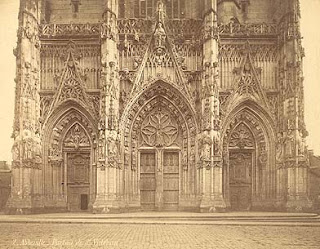The northern French town of Abbeville was a favourite of the art critic and painter John Ruskin.
When he visited in 1868 he wrote with admiration about the view of the gothic church of St Vulfran towering above medieval houses and marketplace.
Watercolours and sketches that he made at the time can still be seen in the Ashmolean Museum in Oxford, but while the 15th-century church that so impressed him is clearly recognisable today, the medieval centre that so captivated Ruskin has largely disappeared.
In May 1940, the town, which is situated around 80 miles south of Calais, was heavily bombed and many of its buildings were destroyed.
A short walk away from the centre there are still many impressive 19th-century houses and the town remains a thriving commercial centre, but the streets and squares around St Vulfran are now mostly characterised by 1950s architecture.
The church itself was so badly damaged in World War II that it took over 40 years to rebuild.
Both inside and out it still bears the scars, but its ornate façade remains exceptional; its doors flanked by depictions of the saints, while a positive legion of gargoyles occupy its higher levels.
 |
| St Vulfran: ornate and gothic |
At the top of the bell-tower, two restored turrets mark the spot where municipal firewatchers would once have looked out over their town keeping an eye out for any signs of smoke.
Amid the tightly packed wooden buildings of medieval Abbeville fire could have proved disastrous.
Source of the town’s prosperity in those days was maritime trade and both the River Somme and the Canal de la Somme, which pass through the town 100 metres or so from St Vulfran, provide a reminder of the days when ships would dock in the shadow in the church.
Walking south from the centre, past an impressive range of fountains, boulangeries and delicatessens, it’s possible soon to be strolling under trees along the banks of the fast-flowing Somme.
A monument by the main bridge over the river stands out. It commemorates the Chevalier de la Barre, executed in 1766, supposedly for failing to take off his hat when a religious procession went past.
The memorial depicts a torturer doing something unmentionable to the Chevalier’s feet, while a sinister-looking member of the Inquisition looks on with interest.
La Barre was one of a group of probably rather foolish young noblemen who, to a greater or lesser degree inspired by the writings of the likes of Voltaire, appear to have gone out of their way to annoy the Church.
While his better-connected confederates managed to either slip away before they were apprehended or were let off with lesser punishments, de la Barre received the full force of the law and a few years later was to become a cause celebre for Revolutionaries looking to emphasise the evils of the established clerical order.
 |
| Musée Boucher de Perthes |
Another famous local figure, the archeologist and antiquary Jacques Boucher de Crèvecœur de Perthes, is commemorated in a more pleasant manner a few streets away in a former bell-tower that is now a museum both to his work and to the history of Abbeville.
While the museum is one of those that has quite a few flints and fragments of pot (Boucher de Perthe’s area of interest lay in all things Stone Age) as well as stuffed birds and beasts, it does also provide some interesting insights into the history of the town and its local artists.
A highlight is the work of Roger Agache, who specialised in using aerial photography to discover the archeological secrets of the region.

No comments:
Post a Comment